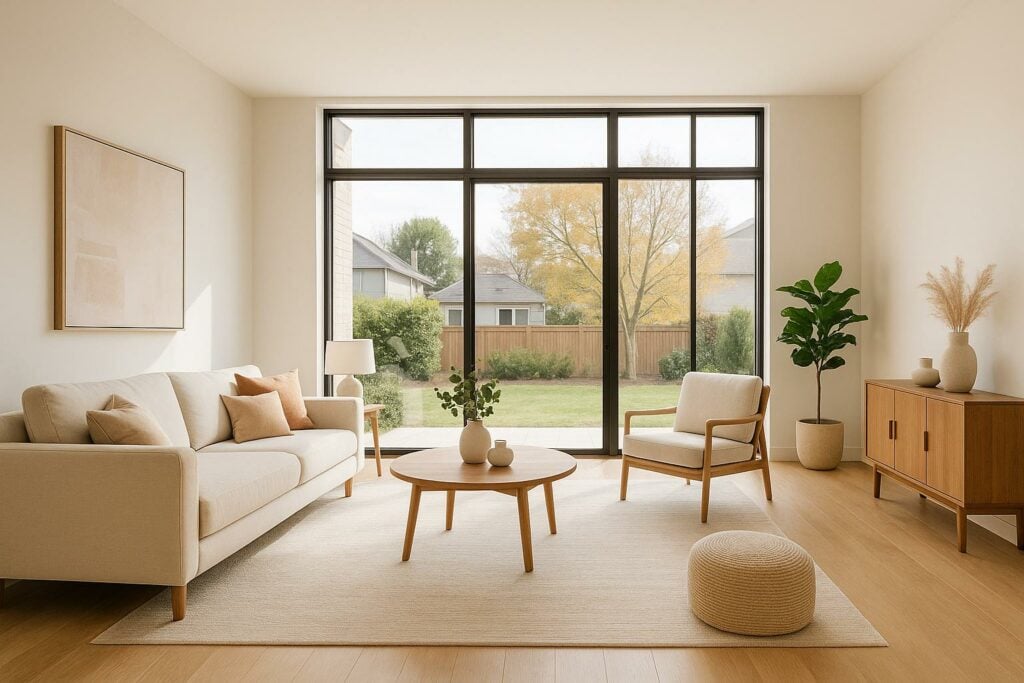In today’s competitive real estate market, one factor consistently sets high-performing properties apart: professional photography. With 97% of homebuyers starting their search online, the visual appeal of a listing has become the driving force behind buyer engagement. Yet, many listings still rely on dark, blurry, or poorly composed photos, often taken with smartphones. These subpar images not only fail to capture attention but can actively repel potential buyers.
This article dives deep into why professional real estate photography is no longer optional but essential for success in a digital-first marketplace. Backed by research, we’ll explore how high-quality photography affects key metrics like days on market and sale price. We’ll also discuss what makes professional visuals effective and how real estate professionals can leverage them to enhance their listings.
The Impact of Professional Photography on Real Estate Metrics
Faster Sales and Higher Prices
Research proves that listings with professional photos consistently outperform those without. According to data:
- Homes with professional photography sell faster: A study by VHT Studios found that professionally photographed homes sold 32% faster, reducing average days on market from 45 to just 31 days. Similarly, another study showed these homes sell 50% faster overall.
- Higher sale prices are the norm: Professionally photographed homes net higher returns, often selling for $3,400 to $11,200 more, depending on the price range. For example, homes in the $400,000 to $500,000 range saw an additional $3,000 to $4,000 added to their sale price.
Increased Buyer Engagement
The connection between stunning visuals and buyer interest is undeniable:
- Listings with professional images receive 118% more online views compared to those with amateur photos.
- A Redfin eye-tracking study revealed buyers spend 60% of their time looking at listing photos, with only 20% allocated to the property description and 20% to agent comments.
The takeaway? Buyers judge listings primarily through visuals, and better photos mean higher engagement, more showings, and ultimately, better offers.
What Sets Professional Real Estate Photography Apart
Many assume professional photography simply means using a better camera – but it goes far beyond that. Here’s how professionals elevate listing photos to create maximum impact:
1. Lighting and Exposure
- Professionals blend natural and artificial light to produce bright, inviting spaces.
- They eliminate common issues like harsh shadows, overly bright windows, or underexposed rooms that make spaces appear smaller or uninviting.
2. Composition and Perspective
- Proper angles and wide-angle lenses create a sense of spaciousness while avoiding distortion.
- Professionals ensure that rooms are showcased accurately, making them feel both functional and aspirational.
3. Post-Processing and Editing
- Expert editing ensures consistent color balance, exposure levels, and vertical alignment throughout the images.
- This "digital staging" enhances a property’s appeal without crossing the line into misrepresentation.
4. Comprehensive Coverage
- While amateur listings may feature just five or six random photos, professionals provide 25 to 50 systematically captured images that showcase every room, outdoor space, and detail.
- This thorough visual tour helps buyers develop a deeper understanding of the property before scheduling a showing.
5. Visual Storytelling
- Professional photographers guide buyers through a logical flow of the home, starting with the exterior and moving through public spaces to private areas.
- This storytelling approach helps buyers envision themselves living in the space, creating an emotional connection.
The Evolution of Visual Content in Real Estate
The expectations of today’s homebuyers have shifted dramatically. With the majority of house hunters beginning their search online, they now demand high-quality visual content that allows them to evaluate properties thoroughly. Here’s what modern buyers expect:
- Complete visual transparency: Buyers want to see every room, outdoor area, and detail before considering a property for an in-person visit.
- Multiple media formats: 3D virtual tours, drone footage, and floor plans have become standard additions to still photography for many listings.
- Mobile optimization: As buyers increasingly browse listings on smartphones, high-quality images that stand out in thumbnail format are essential.
The rise of virtual and hybrid buying processes, accelerated by the pandemic, has also made professional media more crucial than ever. Many buyers now make offers on homes they’ve only seen virtually, underscoring the importance of quality visuals.
The Financial ROI of Professional Photography
One of the most compelling aspects of professional photography is its return on investment (ROI). While the cost of a basic photography package ranges from $150 to $500, and luxury media packages can reach up to $2,000, the potential returns far exceed this initial expense.
- For a $500,000 home, investing in professional photography can yield a $5,000 price premium with just a 1% increase in sale price.
- Faster sales also reduce carrying costs like mortgage payments, utilities, and property taxes, delivering further financial benefits.
The misconception? Professional photography is only for luxury homes. In reality, middle-market properties often see the largest percentage improvements in metrics like days on market and sale price.
Addressing Common Misconceptions
Despite the overwhelming evidence, many real estate professionals and sellers hesitate to invest in professional photography. Here are four common myths and the truths behind them:
- Myth: Smartphone cameras are good enough.
- Reality: While smartphone cameras have improved significantly, they lack the dynamic range, lens options, and lighting control of professional equipment. More importantly, they lack the expertise of a professional photographer.
- Myth: Professional photography is for luxury homes only.
- Reality: Listings at all price points see benefits, with middle-market homes often experiencing the largest gains.
- Myth: In a seller’s market, photos don’t matter.
- Reality: Even in hot markets, professional photos help homes sell faster and for more money. As markets cool, quality visuals become even more critical to stand out.
- Myth: Buyers care more about price and features than photos.
- Reality: Poor visuals can prevent buyers from considering a property in the first place, regardless of its price or features.
Key Takeaways
- Listings with professional photos receive 118% more online views and sell for up to $11,200 more.
- Homes with professional photography sell 32% faster, reducing days on market significantly.
- Key elements of professional photography include superior lighting, composition, and post-processing.
- Buyers expect comprehensive, high-quality visuals, including 3D tours, drone footage, and floor plans.
- Professional photography offers a 10x to 20x ROI, especially in middle-market listings.
- Real estate agents should make professional photography a standard part of their marketing strategy.
Conclusion
In the digital-first world of real estate, professional photography is no longer a luxury – it’s a necessity. The data is clear: high-quality visuals drive faster sales, higher prices, and greater buyer engagement. As a real estate professional, investing in professional media isn’t just about selling a home – it’s about building a brand that reflects excellence and professionalism.
By prioritizing professional photography and comprehensive visual packages, agents can ensure their listings not only stand out but also deliver exceptional results for their clients. The first impression buyers get from a listing photo could very well be the deciding factor in their journey toward purchasing a home.
Source: "Why Every Real Estate Listing Needs Good Media" – Flux Media, YouTube, Aug 29, 2025 – https://www.youtube.com/watch?v=bMpKJtXWJTQ
Use: Embedded for reference. Brief quotes used for commentary/review.











